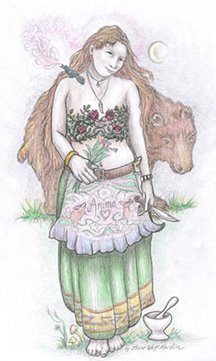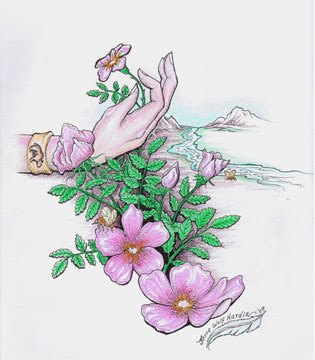
Monarda is a common Gila plant, preferring to grow in pine-inhabited arroyos. It's hardy and thrives through both floods and droughts, making it one of my most dependable primary medicines. Although this plant has a huge variety of uses, one area it really stands out is yeast infections. I have never used any herb (or even any pharmaceutical) that works so consistently. Especially if caught in the early stages, Monarda will keep the infection from ever getting off the ground. I take half a dropperfull of the tincture every two hours for the first few days, and then taper off as symptoms disappear. I've also used an infusion of dried leaves with similar results, I recommend mixing it with mint, roses and oatstraw to mellow out the intense taste. As a warning, it makes me rather sleepy even in small doses, though it doesn't seem to effect everyone that way.
Below is yet another one of my herbal essays (yes, I am writing a book). It was written this past fall after the extra abundant monsoon rains we experienced, making for some very happy Monarda. Mountain Monarda: One of North America’s Most Important Medicines By Kiva Rose
Mountain Monarda: One of North America’s Most Important Medicines By Kiva Rose
(Monarda fistulosa var. menthaefolia) Common Names: Wild Bergamot, Monarda, Bee-Balm, Wild Oregano, Oregano de la Sierra , Sweet Leaf
Energetics: warm feeling, but cooling at core, diffusively stimulating/relaxant
Primary Actions: Diffusive stimulant, relaxant nervine, anti-spasmodic, diaphoretic, carminative, emmenagogue
I have long been amused by accounts of medical anthropologists running off to the Amazon to discover new drugs, when I have learned so much... right here in North America.
-Matthew Wood
The sun is just beginning to peak over the mist laced canyon walls as my partner Loba and I walk up the narrow arroyo that winds like a serpent from the canyon bottom deep into the Saliz Mountains. All around us, Autumn is beginning to blossom in innumerable shades of gold. The bright flowers of Groundsel, Snakeweed and Deer Vetch peek from around almost every rock, and the Goldenrod is just beginning to open its sunny spikes. On on a rocky ledge above us, we see a brilliant and unexpected splash of magenta, and from where we’re standing we can smell the pungent oregano aroma wafting our way. Excited to discover such profusion so late in the season, Loba and I eagerly clamber up to the ledge and begin to fill our harvesting baskets with the bright blossoms and aromatic light green leaves of Mountain Monarda.
According to herbalist Matthew Wood, Monarda is one of the primary healing plants native to North America and has long been used as a primary medicine by Native Americans across the continent including the Hopi and Cherokee, and is still included in many Plains Tribe ceremonies like the Sweat Lodge and the Sun Dance. Seemingly neglected by anglo herbalists and doctors, it is currently enjoying a small surge in interest thanks to Monarda enthusiasts who have been touting its benefits for years. I’m thrilled to be surrounded by this beautiful plant in New Mexico, where it’s found in nearly every arroyo I’ve visited in the mountains.
Often confused with Monarda pectinata, with whom it shares many characteristics and traits. In my experience, Mountain Monarda has very bright pink to purplish flowers and grows in damp, rocky areas such a arroyos, while M. pectinata has white to pale lavender flowers and generally grows in less rocky environs such as river banks roadsides and grassy meadows. Both Monardas have a very strong lemon-oregano scent that Loba and I enjoy as a tasty addition to salsa, beans or any Mexican or Italian dish instead of Oregano, and can also be used as a delicious ingredient in many salads. Some people greatly enjoy the flavor of the tea as a relaxing beverage. The leaves are the most commonly used part of the plant, but the flowers are also excellent and extra spicy. The midsummer flowering season – when its aromatics are at their peak – is the best time to harvest it, but it can be gathered at any time. It can easily be preserved in a tincture, glycerite, vinegar, oil or syrup and it works just fine hung up in bunches to dry as well. Both Monardas have very similar uses, but I will be specifically referring to Monarda fistulosa var. menthaefolia throughout this article since most of my experience has been with that species.
Although folks here in the Southwest are most likely to call it Wild Oregano or Oregano de la Sierra for its strong spicy aroma and tendency to grow in the mountains, Monarda has a great many common names. Some refer to it as Sweet Leaf in reference to the old Indian names for the plant, or Indian Perfume. Many people know it as the Bee-Balm of their hummingbird and butterfly gardens, and I’ve also heard people from back east call it Oswego Tea after the eastern relative used a tea substitute. I’ve taken to calling our particular species Mountain Monarda to distinguish it from its myriad relatives.
Many members of the mint family share certain similar characteristics. Monardas, Sages, Mints, Thyme and Oregano are all strongly anti-bacterial, nervine and anti-inflammatory, making them excellent for a wide variety of ailments and afflictions. Collectively, they may be best known as a remedy for an upset stomach, our own Mountain Monarda being no exception. A strong tea or small dose of tincture can be used to soothe almost any gastric upset including heartburn, nausea, diarrhea, constipation, stomachache or gas.
Powerfully anti-bacterial, anti-inflammatory, antiseptic, anesthetic, styptic and anti-fungal I frequently use the leaves and flowers in salves and oils for wounds, sprains, bruises, burns, rashes and other external pains to bring down swelling, eliminate infection, reduce irritation, dull pain and stem excess bleeding. It’s especially good combined with Sage or Yarrow for an even stronger blend, or apply the salve to a bandage made of Usnea lichen for any sort of infected wound. I also use Mountain Monarda as a cooling wash or vinegar for sunburns and other burns.
Long recognized as a powerful woman’s herb by Native peoples and old time doctors, Monarda was considered an excellent reproductive tonic in the 19th century and was given as a traditional gift to young brides to regulate and improve their cycles. Combine Monarda infused (not essential) oil with Mugwort or American Pennyroyal infused oil and apply to the lower abdomen to ease menstrual cramps or other cyclical discomforts. It has also been employed traditionally to bring on delayed menses. Because of this, it probably should not be used in infusion or tincture form during pregnancy, though it can still be eaten as a food without problem. A key herb in treating recurring or chronic yeast infections and leaky gut syndrome, try the tincture in small doses over a period of time if you have symptoms of either of these illnesses. Oil of Oregano is currently a popular item in alternative medicine for combating candida and various infections, but what most people do not know is that the active constituent of Oil of Oregano is present in large amounts in our own Monarda. For anything you might use Oil of Oregano for, you can substitute the prolific (and cheap) Monarda.
Its also recently become well known as a valuable remedy for cystitis, especially urinary tract infections with symptoms of severe burning. Monarda will help cool the irritated membranes while also eliminating the infection. I have personally found this to be the quickest acting remedy for almost any “hot” bladder problem with symptoms of burning and inflammation, combine with Manzanita and Goldenrod for the best results. A gentle but effective nervine, Mountain Monarda acts upon the nervous system in a soothing way, and can be used as a calmitive and antidepressant much in the same way as its cousin Lemon Balm. It shares Lemon Balm’s sunny disposition and easy going ways, making it a fine remedy for children. It is quite gentle and completely non-addictive, not acting as an outright sedative so much as a physical reminder to relax and smile. Monarda has also been used successfully for nervous system related disorders such as Meniere’s disease and tinnitis.
Diaphoretic, anti-spasmodic and anti-viral, Mountain Monarda is an excellent treatment for any cold or flu you might catch this coming Winter, especially those accompanied by coughing, sore throat, chest congestion and fever. It’s particularly effective combined with Elderberry and Yarrow. The same anesthetic properties that make it useful for wounds and burns also make it a wonderful cure for sore, abraded throats. It’s extra nice when made into a simple honey syrup to soothe and heal many coughs, sore throat or lung trouble. For this you’ll need a canning jar and some good raw honey (it’s importantly to use raw and unpasteurized for it’s powerful antibiotic qualities) plus enough fresh Mountain Monarda flowers to fill the jar. First, place the flowers in the jar, then cover them completely with honey, stir with a chopstick or long handled spoon to remove air bubbles. Then cap, and sit in a sunny window for 4 to 6 weeks. That’s it! Then you can either strain the honey from the flowers and compost the plant matter, or else leave the flowers in the honey. Either way, store in a cool place away from direct light. Add the syrup to tea or take it straight.
The warm sun is almost directly overhead as Loba and I finally head back down the rocky path towards home. Our baskets are nearly bursting with Monarda, Valerian root, Goldenrod, Yarrow, Sage and a few choice wild mushrooms. The cool crisp breeze fills the air with the rich aroma of wildflowers and the previous night’s rain as we weave our way through glittering stones and knotted tree roots. We’re eager to hurry home so we can carefully bundle and hang our harvest from the cabin ceiling, preserving our abundance for wonderfully warm winter meals, lovingly brewed medicines and spicy teas.
Resources:
The Book of Herbal Wisdom by Matthew Wood
Medicinal Plants of the Mountain West by Michael Moore
Monday, February 5, 2007
Monarda
Posted by
Oakmoss Changeling
at
7:42 PM
![]()
Labels: Medicine Woman Materia Medica
Subscribe to:
Post Comments (Atom)
The Medicine Woman is glad you came...
All writings & posts (c)2007 Kiva Rose
All artwork & photographs (c) 2007 Jesse Wolf Hardin












4 comments:
Very nice description of such a wonderful plant. It is one my favorite allies I learned in Arizona...and so glad to know it grows up here in the rockies too!
canyon monarda is especially nice...the tincture i made at the plant spirit medicine gathering is just lovely!!
It feels pretty hot to me in general, but is a strong diffusive diaphoretic....so definately helps cool down a hot, congested and stuck, condition.
It does feel hot, at least at first, but have you ever tried it on a burn? It doesn't seem like just the diffusive qualities could cool to that degree. Perhaps it's a bit like Yarrow and can do both?
Perhaps...but I also suspect that the menthol/thymol in the plant is topically anodyne, easing the pain. You've probably used it more than I have in a wider variety of situations, so..you may be right. I've not tried it on burns. But it feels intensely warm to me...perhaps like yarrow, warmer in hot water and cooler in cold infusion.
ANyone else want to chime in on their thoughts on the energetics??
Time to whip that tincture out. Maybe next weeks herb of the week....
Hmm, yes perhaps... I almost always have reactions to warming herbs that tell me my body considers them warm (usually instant stomach upset) and I actually feel cooler, but I guess that could be the diffusive action as well. I have met Monardas who feel hot to me but this particular Monarda I've always thought of as cooling... Cook says that Monarda (in this case Punctata I think) is very like Oregano but lacks its fiery nature... and Michael Tierra classifies it as a Cooling relaxing diaphoretic. This is when energetics confuse me a bit. Crazy mint family plants.
I just read a piece by Terry Willard that said some Native tribes used Monarda fistulosa to strengthen the heart, ever used it that way before?
Post a Comment